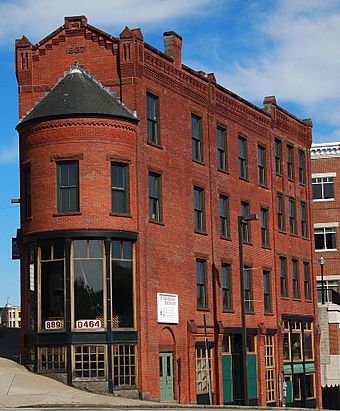Carroll Building (Norwich, Connecticut) facts for kids
|
Carroll Building
|
|
|
U.S. Historic district
Contributing property |
|
 |
|
| Location | 9-15 Main St., and 14-20 Water St., Norwich, Connecticut |
|---|---|
| Area | 0.1 acres (0.040 ha) |
| Built | 1887 |
| Architect | Stephen C. Earle |
| Architectural style | Romanesque |
| Part of | Downtown Norwich Historic District (ID85000707) |
| NRHP reference No. | 82001007 |
Quick facts for kids Significant dates |
|
| Added to NRHP | November 14, 1982 |
| Designated CP | January 17, 1973 |
The Carroll Building in Norwich, Connecticut, is a cool old building. People sometimes call it the Flat Iron Building because of its unique shape. It was built way back in 1887. This building is so special that it's listed on the National Register of Historic Places (NRHP). It's also part of the Downtown Norwich Historic District.
The Carroll Building used to have offices and shops. Now, it's mostly an apartment building. It sits on a triangular piece of land where Main Street and Water Street meet. You can easily spot it from Washington Square. It's one of the most famous buildings in downtown Norwich. Currently, the building is empty.
Contents
What is the Carroll Building?
The Carroll Building was ordered by Lucius W. Carroll. He was a merchant who invested in many things, like textile mills. This building was his way of investing in real estate. It helped develop downtown Norwich.
The famous architect Stephen C. Earle from Worcester, Massachusetts designed the building. His design was similar to another building built a year earlier, but it was even better. Stephen C. Earle designed other buildings in Norwich too. Many businesses rented space here, including the Southern New England Telephone company for several years.
Why is its design special?
The Carroll Building was built in 1887. It stands on a unique triangular spot where Main Street and Water Street cross. This area has different ground levels. So, the building's design had to be very clever to fit.
The land slopes up and down in different directions. The building covers the whole site. It is four or five stories tall, depending on where you look. A round tower, about 18 feet wide, sticks out at the corner where the streets meet.
What is its modern use?
In the late 1980s, Norwich made a rule for property owners. It said buildings must look well-kept. If not, owners could get fined. This meant the owners of the Carroll Building had to make it look better.
The building was also part of a "Walking Through History" guide. In 1992, the Connecticut Trust For Historic Preservation said the Carroll Building was one of the most important historic sites in danger.
In 2012, a group called Norwich's Vibrant Communities Initiative (NVCI) noted the building was empty. The Carroll Building is at 9-15 Main Street. The same owner also owns 16 Main Street across the street. This other spot used to be a Dunkin' Donuts shop, but it's now empty too.
The NVCI group said the owner wanted to sell both properties. They also noted that the Carroll Building is very important to the city. Even though it has a unique floor plan, they thought it would be great for apartments. The old Dunkin' Donuts spot could even provide parking spaces.
Why is the Carroll Building important?
The Carroll Building is a great example of Romanesque-style architecture. It's the best example of this style for a business building in Norwich. The architect, Stephen C. Earle, was inspired by Henry Hobson Richardson.
The building's design is amazing because it fits the tricky triangular spot so well. It uses the different ground levels for shops on the lower floors. It's like two separate buildings connected by a staircase.
The Carroll Building is also important for history. It shows how real estate worked in the city in the late 1800s. Lucius W. Carroll didn't use the building for his own office. Instead, he rented it out as an investment. This was a common way for wealthy people to build in downtown Norwich. The building also stands out when you see it from Washington Square. It's a key part of the downtown area.



